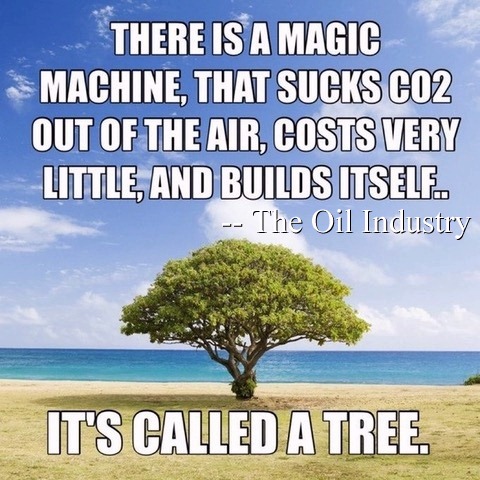
By Daniel Brouse
June 28, 2023 (Updated June 21, 2024)
Giving carbon offsets for planting trees and allowing for the continued use of fossil fuels is greenwashing and accelerates the pace of climate change. This meme is an example. Unfortunately, the meme was created by the oil industry to spread misinformation. Trees are not machines; they are inefficient 'carbon capture facilities' and cannot substitute for reducing fossil fuel consumption.

Example #2 Following is a in response to "Animal Agriculture is the Leading Cause of Climate Change".
I said, "About the paper, it is not a good paper. It is flawed in several ways. The main problem with the paper is it depends on "the potential to sequester over 2000 Giga tons." No amount of sequestering will solve our problem. Sequestration is only a temporary solution. The most important thing for people to do is stop the use of hydrocarbon based products today... followed by everything else. Minimize consumption of everything.
Plant vegetation sequestration only lasts for several years (with old growth hardwood some sequestration may last up to 100 years.) We wrote a paper on it a few years ago. Though the paper focuses on hemp, it covers all vegetation (The Hemp Myth, Carbon Sinks and the Environment).
Some people argue that we can not abruptly stop the use of fossil fuels or it will cause social unrest. The total collapse of society is inevitable. Even if we stopped using fossil fuels today, we have already baked in a rise of 2 degrees Celsius. "The Earth will exceed 1.5℃ (average global surface temperature over the surface of the earth for ten years) by the 2040's and a societal collapse will ensue. For the most part, the Earth will be uninhabitable for humans by 2070 UNLESS immediate action is taken. " -- Brouse and Mukherjee (c.2020)
Trees do not permanently sequester carbon. Much of the carbon stored in a tree is in the leaves, which usually last under a year. In one case study, the average life of a tree planted for carbon credit sequestration was 7 years. Additionally, 'Tree Extinction Due to Human-Induced Environmental Stress' is already lowering the life expectancy of all trees. It is extremely rare for a tree to sequester carbon for the approximate 100-year lifespan of carbon in the atmosphere. You cannot burn carbon that has been sequestered for millions of years and expect trees to help in the long run. The important role of trees in climate change is their role as guardians of the soil. In general, climate scientists are against the use of tree sequestration for carbon credits. Giving carbon offsets for planting trees while allowing for the continued use of fossil fuels is greenwashing and accelerates the pace of climate change
THE OIL INDUSTRY STRATEGY
The fossil fuel industry uses carbon offsets as a strategy to maintain and even expand the use of fossil fuels while attempting to address concerns about climate change. Here's how this works:
THE REAL PROBLEM
The exact amount of O2 contributed and CO2 absorbed is a complicated equation on a daily or yearly basis. Trees both absorb and emit CO2. However, this calculation is relatively meaningless because CO2 has an average lifespan in the atmosphere of 100 years. In contrast, 99% of a tree's carbon has an average cycle of 7 years. Essentially, 0% of the CO2 causing climate change is stored in a tree. The importance of trees and forests lies in their role within the soil ecosystem. Trees act as caretakers for the CO2 stored in the soil.
CANADIAN WILDFIRE CASE STUDY
For a frightening example, look at the forest fires in Canada. These fires are more intense and frequent due to human CO2 emissions. Last year, Canada's largest contributor to CO2 emissions was wildfires. While this may not be a significant factor in the long term, as that CO2 would have returned to the atmosphere within 50 years anyway, it creates a feedback loop that accelerates climate change.
But it gets worse. The real feedback loop problem is the permafrost. Forest fires and a warming climate have ignited the permafrost, causing 'zombie fires' that burned all winter under the snow and continue to burn this year. Millions of years of CO2 are stored in the permafrost. While we do not know exactly how much carbon is stored in nature, it is reasonable to assume that temperatures could be pushed from 3 degrees to 6 degrees above pre-industrial levels. Humans cannot thrive above a rise of 1.5 degrees. Much of the Earth will be uninhabitable if the temperature rises an additional 6 degrees Celsius. If humans also add 3 degrees Celsius, the temperature and humidity will approach a wet-bulb temperature that will not sustain human life.
REFERENCES
To support the statement "Giving carbon offsets for planting trees and allowing for the continued use of fossil fuels is greenwashing and accelerates the pace of climate change," here are some references:
Also see:
Soil Degradation and Desertification
The Decline of Penn's Sylvania: Trees and Temperate Zones
The Album 'Wood You Save the Trees?' by The Beatless Sense Mongers